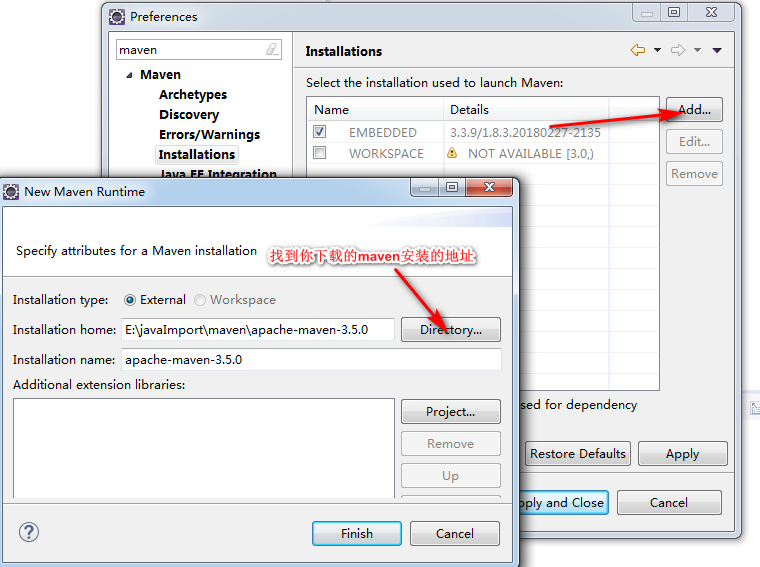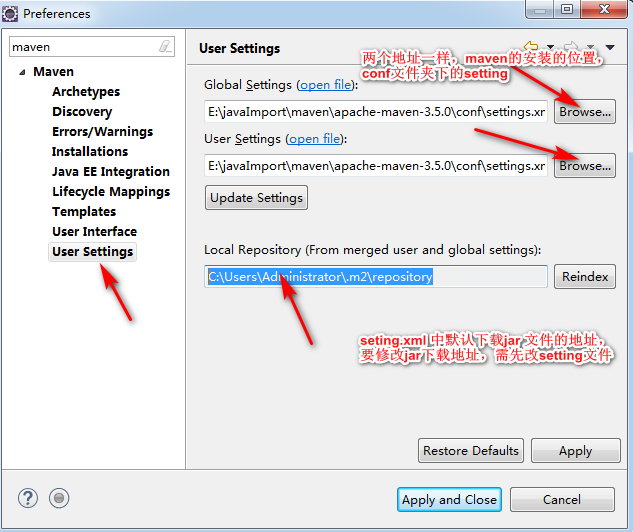Maven -------------- Eclipse 安装maven ,配置setting文件
1、设置maven路径
Window->Preferences->Maven->Installations->

选择maven的路径,如果原来有低版本的建议删除
选择好后点击finish

设置仓库路径
菜单->Window->Preferences->Maven->User Settings->
Global Settings 和 User Settings都使用,你maven安装的地方,找conf 文件夹下的 settings.xml
E:\javaImport\maven\apache-maven-3.5.0\conf\settings.xml
点击一下Reindex,确保 local Repository:


修改jar文件下载地址,修改setting.xml 文件
该地址
<localRepository>d:/maven/repository</localRepository>
maven 会默认从maven官方提供的服务器下载jar包。
而官方服务器在国外,由于,网速很慢,而且容易卡断。 为了便于快速下载相关jar包,可以使用国内maven 阿里云的下载地址
<mirror>
<id>alimaven</id>
<mirrorOf>central</mirrorOf>
<name>aliyun maven</name>
<url>http://maven.aliyun.com/nexus/content/repositories/central/</url>
</mirror>
完整的setting文件
链接:https://pan.baidu.com/s/1YxRftJmdv714_LoWqeTUmg
提取码:92js
<?xml version="1.0" encoding="UTF-8"?> <!--
Licensed to the Apache Software Foundation (ASF) under one
or more contributor license agreements. See the NOTICE file
distributed with this work for additional information
regarding copyright ownership. The ASF licenses this file
to you under the Apache License, Version 2.0 (the
"License"); you may not use this file except in compliance
with the License. You may obtain a copy of the License at http://www.apache.org/licenses/LICENSE-2.0 Unless required by applicable law or agreed to in writing,
software distributed under the License is distributed on an
"AS IS" BASIS, WITHOUT WARRANTIES OR CONDITIONS OF ANY
KIND, either express or implied. See the License for the
specific language governing permissions and limitations
under the License.
--> <!--
| This is the configuration file for Maven. It can be specified at two levels:
|
| 1. User Level. This settings.xml file provides configuration for a single user,
| and is normally provided in ${user.home}/.m2/settings.xml.
|
| NOTE: This location can be overridden with the CLI option:
|
| -s /path/to/user/settings.xml
|
| 2. Global Level. This settings.xml file provides configuration for all Maven
| users on a machine (assuming they're all using the same Maven
| installation). It's normally provided in
| ${maven.conf}/settings.xml.
|
| NOTE: This location can be overridden with the CLI option:
|
| -gs /path/to/global/settings.xml
|
| The sections in this sample file are intended to give you a running start at
| getting the most out of your Maven installation. Where appropriate, the default
| values (values used when the setting is not specified) are provided.
|
|-->
<settings xmlns="http://maven.apache.org/SETTINGS/1.0.0"
xmlns:xsi="http://www.w3.org/2001/XMLSchema-instance"
xsi:schemaLocation="http://maven.apache.org/SETTINGS/1.0.0 http://maven.apache.org/xsd/settings-1.0.0.xsd">
<!-- localRepository
| The path to the local repository maven will use to store artifacts.
|
| Default: ${user.home}/.m2/repository -->
<localRepository>d:/maven/repository</localRepository> <!-- interactiveMode
| This will determine whether maven prompts you when it needs input. If set to false,
| maven will use a sensible default value, perhaps based on some other setting, for
| the parameter in question.
|
| Default: true
<interactiveMode>true</interactiveMode>
--> <!-- offline
| Determines whether maven should attempt to connect to the network when executing a build.
| This will have an effect on artifact downloads, artifact deployment, and others.
|
| Default: false
<offline>false</offline>
--> <!-- pluginGroups
| This is a list of additional group identifiers that will be searched when resolving plugins by their prefix, i.e.
| when invoking a command line like "mvn prefix:goal". Maven will automatically add the group identifiers
| "org.apache.maven.plugins" and "org.codehaus.mojo" if these are not already contained in the list.
|-->
<pluginGroups>
<!-- pluginGroup
| Specifies a further group identifier to use for plugin lookup.
<pluginGroup>com.your.plugins</pluginGroup>
-->
</pluginGroups> <!-- proxies
| This is a list of proxies which can be used on this machine to connect to the network.
| Unless otherwise specified (by system property or command-line switch), the first proxy
| specification in this list marked as active will be used.
|-->
<proxies>
<!-- proxy
| Specification for one proxy, to be used in connecting to the network.
|
<proxy>
<id>optional</id>
<active>true</active>
<protocol>http</protocol>
<username>proxyuser</username>
<password>proxypass</password>
<host>proxy.host.net</host>
<port>80</port>
<nonProxyHosts>local.net|some.host.com</nonProxyHosts>
</proxy>
-->
</proxies> <!-- servers
| This is a list of authentication profiles, keyed by the server-id used within the system.
| Authentication profiles can be used whenever maven must make a connection to a remote server.
|-->
<servers>
<!-- server
| Specifies the authentication information to use when connecting to a particular server, identified by
| a unique name within the system (referred to by the 'id' attribute below).
|
| NOTE: You should either specify username/password OR privateKey/passphrase, since these pairings are
| used together.
|
<server>
<id>deploymentRepo</id>
<username>repouser</username>
<password>repopwd</password>
</server>
--> <!-- Another sample, using keys to authenticate.
<server>
<id>siteServer</id>
<privateKey>/path/to/private/key</privateKey>
<passphrase>optional; leave empty if not used.</passphrase>
</server>
-->
</servers> <!-- mirrors
| This is a list of mirrors to be used in downloading artifacts from remote repositories.
|
| It works like this: a POM may declare a repository to use in resolving certain artifacts.
| However, this repository may have problems with heavy traffic at times, so people have mirrored
| it to several places.
|
| That repository definition will have a unique id, so we can create a mirror reference for that
| repository, to be used as an alternate download site. The mirror site will be the preferred
| server for that repository.
|-->
<mirrors>
<!-- mirror
| Specifies a repository mirror site to use instead of a given repository. The repository that
| this mirror serves has an ID that matches the mirrorOf element of this mirror. IDs are used
| for inheritance and direct lookup purposes, and must be unique across the set of mirrors.
|
<mirror>
<id>mirrorId</id>
<mirrorOf>repositoryId</mirrorOf>
<name>Human Readable Name for this Mirror.</name>
<url>http://my.repository.com/repo/path</url>
</mirror>
-->
<mirror>
<id>alimaven</id>
<mirrorOf>central</mirrorOf>
<name>aliyun maven</name>
<url>http://maven.aliyun.com/nexus/content/repositories/central/</url>
</mirror> </mirrors> <!-- profiles
| This is a list of profiles which can be activated in a variety of ways, and which can modify
| the build process. Profiles provided in the settings.xml are intended to provide local machine-
| specific paths and repository locations which allow the build to work in the local environment.
|
| For example, if you have an integration testing plugin - like cactus - that needs to know where
| your Tomcat instance is installed, you can provide a variable here such that the variable is
| dereferenced during the build process to configure the cactus plugin.
|
| As noted above, profiles can be activated in a variety of ways. One way - the activeProfiles
| section of this document (settings.xml) - will be discussed later. Another way essentially
| relies on the detection of a system property, either matching a particular value for the property,
| or merely testing its existence. Profiles can also be activated by JDK version prefix, where a
| value of '1.4' might activate a profile when the build is executed on a JDK version of '1.4.2_07'.
| Finally, the list of active profiles can be specified directly from the command line.
|
| NOTE: For profiles defined in the settings.xml, you are restricted to specifying only artifact
| repositories, plugin repositories, and free-form properties to be used as configuration
| variables for plugins in the POM.
|
|-->
<profiles>
<!-- profile
| Specifies a set of introductions to the build process, to be activated using one or more of the
| mechanisms described above. For inheritance purposes, and to activate profiles via <activatedProfiles/>
| or the command line, profiles have to have an ID that is unique.
|
| An encouraged best practice for profile identification is to use a consistent naming convention
| for profiles, such as 'env-dev', 'env-test', 'env-production', 'user-jdcasey', 'user-brett', etc.
| This will make it more intuitive to understand what the set of introduced profiles is attempting
| to accomplish, particularly when you only have a list of profile id's for debug.
|
| This profile example uses the JDK version to trigger activation, and provides a JDK-specific repo.
<profile>
<id>jdk-1.4</id> <activation>
<jdk>1.4</jdk>
</activation> <repositories>
<repository>
<id>jdk14</id>
<name>Repository for JDK 1.4 builds</name>
<url>http://www.myhost.com/maven/jdk14</url>
<layout>default</layout>
<snapshotPolicy>always</snapshotPolicy>
</repository>
</repositories>
</profile>
--> <!--
| Here is another profile, activated by the system property 'target-env' with a value of 'dev',
| which provides a specific path to the Tomcat instance. To use this, your plugin configuration
| might hypothetically look like:
|
| ...
| <plugin>
| <groupId>org.myco.myplugins</groupId>
| <artifactId>myplugin</artifactId>
|
| <configuration>
| <tomcatLocation>${tomcatPath}</tomcatLocation>
| </configuration>
| </plugin>
| ...
|
| NOTE: If you just wanted to inject this configuration whenever someone set 'target-env' to
| anything, you could just leave off the <value/> inside the activation-property.
|
<profile>
<id>env-dev</id> <activation>
<property>
<name>target-env</name>
<value>dev</value>
</property>
</activation> <properties>
<tomcatPath>/path/to/tomcat/instance</tomcatPath>
</properties>
</profile>
-->
</profiles> <!-- activeProfiles
| List of profiles that are active for all builds.
|
<activeProfiles>
<activeProfile>alwaysActiveProfile</activeProfile>
<activeProfile>anotherAlwaysActiveProfile</activeProfile>
</activeProfiles>
-->
</settings>
在配置一下

点击应用就配置好了
Maven -------------- Eclipse 安装maven ,配置setting文件的更多相关文章
- 最细的eclipse 安装maven踩过的坑
Eclipse安装maven插件踩过的坑 在线安装maven eclipse安装maven插件,在网上有各种各样的方法,博主使用过的也不止一种,但是留下的印象总是时好时不好,同样的方法也不确定那一次能 ...
- eclipse安装maven时候如果conf文件夹中有setting文件则会以这个文件为主,如果自己设置了user的配置文件则会无效
eclipse安装maven时候如果conf文件夹中有setting文件则会以这个文件为主,如果自己设置了user的配置文件则会无效
- maven的安装,maven库配置和Eclipse插件的安装
maven的安装,maven库配置和Eclipse插件的安装 1.下载并解压maven 2.配置环境变量 3.配置maven配置文件 1.下载链接 Downloading Apache Maven 2 ...
- Maven的安装及配置、Maven在Eclipse中的配置
一.需要准备的东西 1. JDK 2. Eclipse 3. Maven程序包 二.检查JAVA安装 三.安装Maven 下载apache-maven-3.5.3-bin.zip解压即可. 四.配置M ...
- Maven的安装与配置(eclipse,idea)
Maven的安装与配置 一.需要准备的东西 1. JDK 2. Maven程序包 3. Eclipse 4. Idea 二.下载与安装 1. 前往https://maven.apache.org/ ...
- 一.Maven的安装和配置整理
Maven的安装和配置 1.1安装 进入Maven官网的下载页面:http://maven.apache.org/download.cgi选择当前最新版本:" ...
- maven课程 项目管理利器-maven 3-4 eclipse安装maven插件和新建maven项目
本节主要讲了两个主要内容, 1 eclipse安装maven插件 2 新建maven项目 3 本人实操 1 eclipse安装maven插件 eclipse4.0以上和myec ...
- 【Maven】Eclipse安装Maven插件后导致Eclipse启动出错
本文纯属复制粘贴:具体请参照原文: Eclipse安装Maven插件后,Eclipse启动问题:Maven Integration for Eclipse JDK Warning. 解决方法: 1. ...
- Maven的安装、配置及使用入门
Maven的安装.配置及使用入门 本书代码下载 大家可以从我的网站下载本书的代码:http://www.juvenxu.com/mvn-in-action/,也可以通过我的网站与我取得联系,欢迎大家与 ...
随机推荐
- Python实现抽样分布的验证(正态分布、卡方分布、T分布)
参考链接:https://github.com/v-gazh/LearningStatsGroup/blob/master/week7/week7.ipynb 源地址:https://github.c ...
- 在IE中点击转跳,并打开chorme浏览器继续浏览指定页面,IE自定义ocx控件开发
因项目需要,需要开发一个功能:在IE中点击转跳,并打开chorme浏览器继续浏览指定页面. 分析需求后,参考了: https://www.cnblogs.com/ffjiang/p/7908025.h ...
- Flask应用启动流程
目录 flask应用启动流程 WSGI 启动流程 flask应用启动流程 WSGI 所有的 python web 框架都要遵循 WSGI 协议 在这里还是要简单回顾一下 WSGI 的核心概念. WSG ...
- 响应式开发 纯CSS实现隐藏菜单栏
// 将要隐藏的菜单设置 display: block; // 然后在菜单上面设置一个点击选项,如“菜单”<label for="toggle-checkbox" id=&q ...
- Linux源码编译nginx
1.安装nginx 安装编译工具及库文件 yum -y install make zlib zlib-devel gcc-c++ libtool openssl openssl-devel 首先要安装 ...
- Python字符编码和转码
一:Python2 python2默认编码格式是ascii码,解释器解释代码时会将代码以及代码中的字符串等转换成ascii码再执行.这样会导致字符串输出或传输时,与当前环境编码格式不同的话会显示乱码. ...
- nginx 的 重定向
1. ngx.redirect(uri, status?) 301/302重定向 redirect 为外部重定向,有两种形式: rewrite ^ /foo? redirect; # ngi ...
- Nginx 核心配置-可优化配置参数
Nginx 核心配置-可优化配置参数 作者:尹正杰 版权声明:原创作品,谢绝转载!否则将追究法律责任. 一.nginx的官网查看指令帮助信息方法 1>.打开nginx的官网(https://ng ...
- linux终端下常用快捷键
linu下我常用的快捷键 alt+b 跳转到上一个单词使用 alt+f 跳转到下一个单词使用 Ctrl+c 结束正在运行的程序 Ctrl+d 结束输入或退出shell Ctrl+s 暂停屏幕输出[锁住 ...
- LengthFieldBasedFrameDecoder
LengthFieldBasedFrameDecoder 详解 疯狂创客圈 Java 分布式聊天室[ 亿级流量]实战系列之 -31[ 博客园 总入口 ] 文章目录 LengthFieldBasedFr ...
